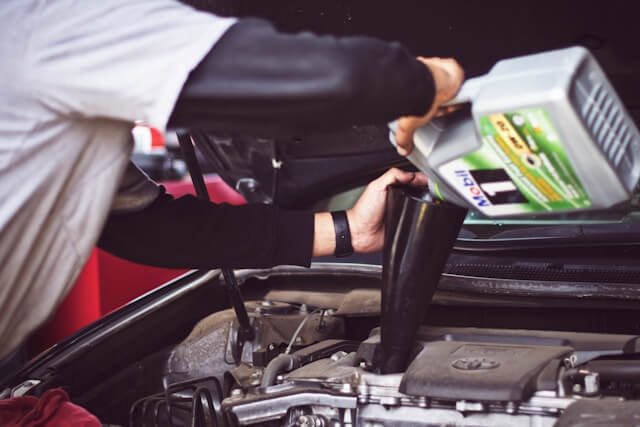The important points
- Regular vehicle maintenance helps prolong the life of your car while reducing long-term maintenance costs.
- Most routine maintenance involves simply inspecting and monitoring various vehicle systems.
- If you discover anything wrong during routine checks, address the underlying issue quickly.
1. Service your car regularly
You’ve probably heard somewhere that your car should be serviced every 5,000 kilometres or every 3 months, or something similar. However, with advances in engines and motor oil, these traditional guidelines have become outdated.
Your owner’s manual, which you should find in the glove compartment, will have a maintenance schedule for your vehicle. As your car ages, your mechanic will adjust this schedule accordingly. Modern cars also have a built-in reminder that will prompt you to get the vehicle serviced.1 Typically, a service includes an oil change, fluid check and change, filter change, tire pressure adjustment, and a general inspection of the vehicle.
2. Check the engine oil
Some new cars use electronic oil monitors to alert you when the oil needs changing, or when the oil level is low. To manually check the oil, you’ll need to use the vehicle’s dipstick. Make sure the car is parked on level ground with the engine off and cool. Pull out the dipstick from the engine and wipe it off before reinserting it into the tube. Pull it out again and check where the oil comes up on the dipstick. If it is below the required line or marking, the oil level is low.
Additionally, the oil’s colour should be tan, caramel, or brown — somewhere in that spectrum. Black oil isn’t necessarily bad, but if black oil is also thick, it can be a sign of contaminants. If it is light or milky, this could mean that coolant is leaking into the engine.2 If you notice any metal particles in the oil, it could mean there is internal engine damage. In either case, take your car to a mechanic.
3. Check the fluids
Your car needs several fluids to run, including coolant, transmission, brake, washer fluid, and, for some vehicles, power steering fluid. A mechanic will check and top them up as needed during regular servicing. If you are topping up the fluids yourself, pay attention to the minimum and maximum indicators on the reservoir, so you don’t underfill or overfill it.
4. Check for leaks
You may notice when your car is parked that it’s leaking fluids. If the fluid is clear, it’s probably water that condensed from the car’s exhaust or air-conditioning system, so no need to panic.
However, if the liquid is dark brown or black, it is probably engine oil. While a small amount of seepage is normal, excessive oil leakage is cause for concern. In this case, check the oil level with the dipstick (see point 2 above). If the oil level is low, take your car to your mechanic or dealership as soon as possible.3
A bright green, pink, orange, yellow or blue liquid is coolant, a fluid that’s vital for keeping your engine from overheating. The liquid will also have a sweet smell. The source of the leak could be a hole in the radiator, a faulty radiator cap, or leaks in the hoses, water pump or engine gasket.4 You should have the car looked at by a mechanic.
A slightly yellowish liquid is most likely brake fluid. Any brake fluid leak can potentially lead to loss of braking power, so have a professional look at your vehicle as soon as possible.
5. Check the tires
Regularly check your tires for wear and tear. Make sure there are no foreign objects lodged in the tire, like nails or sharp rocks.
You also need to check the tread depth of your tires. The tread depth impacts the distance you need to brake safely and should be no less than 1.6 mm (1/16 inches). You can measure this with a depth gauge or a nickel.
If you’re using a gauge, extend the pin, and insert it into the grooves between the treads of the tire. Press down on the base plate of the gauge unit until it’s flush with the tire tread. Repeat this step in at least 4 different spots on each tire for an accurate read. The lowest reading is the most accurate one.
|
Tread depth
|
Action
|
Impact to braking distance
|
|
5/32 inches or greater
3/32 inches or greater
1/16 inches or less
|
Nothing
Consider replacing
Replace immediately
|
Minimal
Significant
Very significant
|
If you don’t have a depth gauge, another quick way to measure your tires is with a nickel. Insert the coin with the monarch’s crown facing down. If you can see the top of the crown, your tire is below 1/16 inches and needs to be replaced.5

You should check your tire pressure every month to make sure it complies with the manufacturer’s recommendations. The recommended air pressure for each tire is indicated in the vehicle owner’s manual or on the sticker that is usually located on the side of the driver’s door. You can measure the pressure with a tire pressure gauge available at any automotive store.
Some vehicles are equipped with a tire pressure monitoring system (TPMS). The device’s warning light is located on the dashboard and switches on when a tire is underinflated.6
You can inflate the tires yourself with an air compressor or with an air pump at most gas stations. It is important to not overinflate the tires, as this could cause them to blow out on the road.



